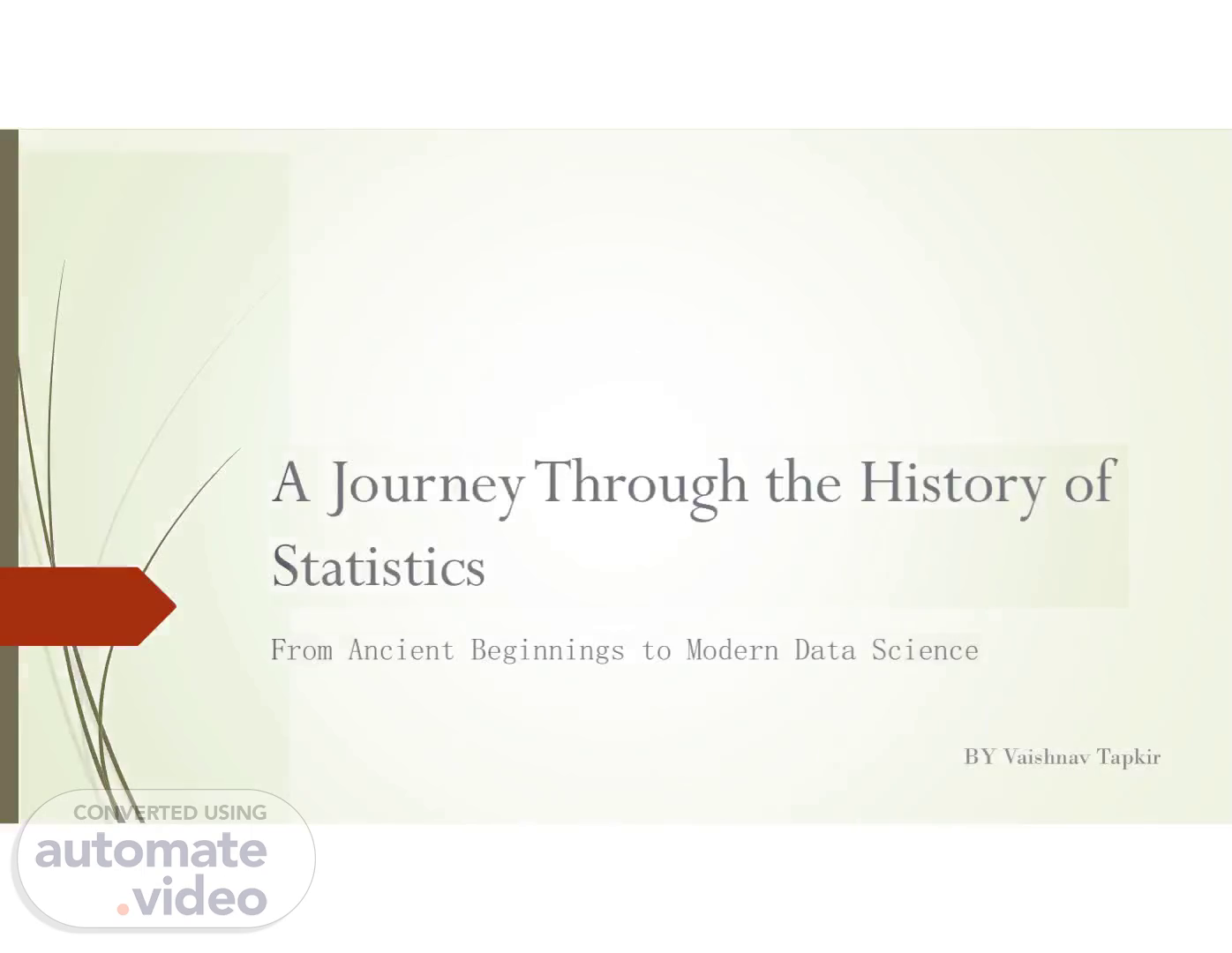
Microsoft PowerPoint - Viashnav activity 2
Scene 1 (0s)
[Audio] A Journey Through the History of Statistics From Ancient Beginnings to Modern Data Science BY Vaishnav Tapkir.
Scene 2 (13s)
[Audio] Introduction Exploring the Rich History of Statistics Subtitle: From Ancient Beginnings to Modern Data Science Brief overview of the presentation's focus and structure. Highlight the importance of understanding the historical evolution of statistics in today's data-driven world..
Scene 3 (36s)
[Audio] Ancient Origin Beginnings in ancient civilizations: Statistical concepts originated in ancient Babylon, Egypt, and Greece, where data collection was used for purposes like taxation and astronomy. Early data collection methods: Early humans developed basic counting and record-keeping systems to keep track of their resources and populations. Historical significance: These early practices laid the foundation for statistical thinking and data analysis. Visual representation: Include images of ancient numerical records and artifacts..
Scene 4 (1m 17s)
[Audio] 17th Century - Probability Theory Emergence of probability theory: The 17th century saw the development of probability theory, with Blaise Pascal and Pierre de Fermat's correspondence on gambling problems. Concept of expected value: This era introduced the concept of expected value, a fundamental concept in probability and statistics. Impact: Probability theory became a key component in statistical reasoning and decision-making. Historical context: Mention the cultural and scientific context of the 17th century..
Scene 5 (1m 59s)
[Audio] 18th Century - Demography and Population Studies Work of Thomas Bayes and Thomas Malthus: Thomas Bayes' theorem and Thomas Malthus' ideas on population dynamics laid the foundation for statistical thinking in demography. Population studies: The 18th century marked the beginning of systematic population studies and demographic statistics. Significance: These developments had a profound impact on understanding population growth and predicting trends. Graphical representation: Include population growth charts from that era..
Scene 6 (2m 40s)
[Audio] 19th Century - Probability and Distributions Carl Friedrich Gauss: Gauss's work in the early 19th century contributed to the development of the normal distribution, a central concept in statistics. Pierre-Simon Laplace: Laplace's contributions to probability and Bayesian statistics expanded the field's theoretical framework. Birth of statistical inference: The 19th century marked the birth of statistical inference and hypothesis testing. Examples: Share historical examples of early statistical applications and experiments..
Scene 7 (3m 22s)
[Audio] 20th Century - Statistical Revolution Development of statistical methods: The 20th century witnessed the development of essential statistical methods like ANOVA, regression, and the t-test. Modern experimental design: New experimental design techniques improved the rigor of scientific research. Applied statistics: Statistics became indispensable in various fields such as medicine, psychology, and social sciences. Visuals: Include graphs illustrating statistical concepts and techniques..
Scene 8 (4m 2s)
[Audio] 20th Century - Sampling and Surveys Random sampling and surveys: The importance of random sampling and survey methods in obtaining representative data. W. Edwards Deming: Deming's contributions to quality control and sampling theory revolutionized industries like manufacturing. Public opinion polling: The 20th century saw the growth of public opinion polling and market research. Charts and survey methodology visuals: Include examples of survey techniques and their impact..
Scene 9 (4m 41s)
[Audio] 20th Century - Computer Age Impact of computers: The role of computers in transforming statistical analysis and data processing. Statistical software: The development of statistical software packages like SAS and SPSS. Data mining and big data: The rise of data mining, machine learning, and big data analytics in the late 20th century. Visuals: Show computers, software logos, and data-related images..
Scene 10 (5m 17s)
[Audio] 21st Century - Data Science Convergence of disciplines: The 21st century marked the convergence of statistics, computer science, and domain expertise in data science. Explosion of data: The unprecedented growth of data and its impact on decision-making and analytics. New statistical techniques: Emerging statistical techniques to handle large and complex data. Data science in action: Provide examples of data science applications.
Scene 11 (5m 54s)
[Audio] Future Trends Role of AI: Discuss the increasing role of artificial intelligence in statistical analysis and predictions. Ethical and privacy concerns: Highlight the growing importance of ethical considerations and privacy in data collection and analysis. Evolving landscape: The continued evolution of statistics in an increasingly data-driven world. Visualize future trends in technology and data..
Scene 12 (6m 26s)
[Audio] Conclusion Summarize the key points of the presentation. Emphasize the enduring importance of statistics in understanding and interpreting the world. Encourage reflection on the journey from ancient origins to modern data science. Conclude with a thought-provoking statement..
Scene 13 (6m 48s)
[Audio] THANK YOU. nox >INVHI. THANK YOU.